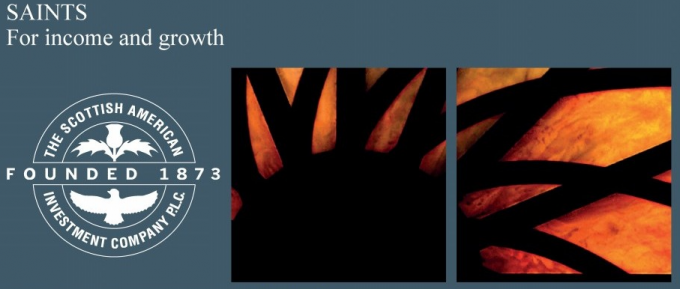Scottish American (SCAM or SAINTS) has announced its annual results for the year ended 31 December 2018. In what it describes as a challenging year for markets, the trust provided NAV and share price total returns of -2.4% and -1.6% respectively. The announcement highlights that these returns are ahead the total return from global equities of -3.4%, and that returns were assisted by the strong operational performance of many of its portfolio as well as by the performance of the trust’s property investments. Unfortunately, the announcement does not include the manager’s review, or any additional detail regarding performance attribution, so it difficult for us to comment on this at this point. However, some of the Chairman’s thoughts on performance and outlook are included below.
Thirty-nine years of consecutive dividend growth
SCAM’s full year dividend, including a recommended final dividend of 2.925p, is 11.50p per share. This fully covered dividend is 3.6% higher than the 2017 dividend, extending the Company’s record of dividend increases to thirty-nine consecutive years. The announcement highlights that this increase is ahead of UK CPI inflation over the same period, which was 2.1%.
Chairman’s comments on total return performance
“Over the year your investment in SAINTS delivered a share price total return of -1.6% and the net asset value total return (capital and income) was -2.4%. Global Equities fell 3.4% over 2018. It is encouraging that, having outperformed a strong market last year, the Trust has more than held its own in the end-of-year downturn. As always however we would caution against reading too much into short term relative performance. The Managers and your Board have a long-term perspective and the Company’s portfolio of investments differs markedly from the make-up of the global equity index against which performance is often compared. This differentiated portfolio is necessary and appropriate in order for the Company to deliver a high and growing income stream, as well as to deliver real growth in the Company’s capital.
Nonetheless, it is worth highlighting that the Company’s property investments have delivered both a high income and capital growth in a year when many parts of the property market have struggled. This is a notable outcome of the property managers’ emphasis on strength of covenant and the consequent evolution of the portfolio away from the retail sector, and this latter shift should increase the resilience of the portfolio to any further weakness from the UK consumer. Pleasingly, SAINTS’ equities held up relatively well in the troubled last quarter. And, as in previous years, returns over 2018 have been helped by the sound operational performance of the companies in which the portfolio is invested. The principal contributors to and detractors from performance and the changes to the equity, property and bond investments are explained in more detail in the Managers’ Review.”
Chairman’s comments on outlook
“Last year I suggested that the likelihood of continued economic growth around the world seemed strong, but that concerns relating to valuations and rising interest rates made share price progress less than certain. This year the opposite may be the case, both because economic growth is likely to slow as the cycle progresses and trade wars loom large and because recent falls make equity valuations appear more reasonable. Appearances may be deceptive however, particularly if corporate earnings growth slows dramatically from the strong levels of 2018.
Wild cards such as Brexit, the extent of any slowdown in China, international trade relations and the broader geopolitical risk around China and the US make predictions challenging as quite different outcomes are entirely possible. Against this uncertain background, the Board and the Managers continue to view it as a strength that the Company’s underlying investments are closely aligned with its long-term objectives. Holdings in companies which maintain dividends in troubled times, and which also grow cashflows and dividends ahead of inflation over the long term, should help SAINTS to do the same, and the resilience shown by the property portfolio also bodes well for the future.
The Board and the Managers remain alert to both potential opportunities and challenges. In the current environment the Managers are correctly focussed on the resilience and dependability of the Company’s holdings, as well as their long-term growth potential, as is explained further in their report. As a Board, we remain of the view that a long-term approach based on investing for sustainable growth is the best route to achieving SAINTS’ aim of growing the dividend over time. We have great confidence in the Managers’ approach, and this confidence has been strengthened by another year of generally encouraging operational performance from the holdings in the portfolio.”
About Scottish American
Scottish American invests in a broad range of UK and international assets. It invests mainly in equity markets, but other investments may be held from time to time including bonds, property and other asset classes. There are no pre-defined maximum or minimum exposure levels for asset classes, sectors or regions.
The Board caution that Scottish American’s performance in any one year is likely to differ from that of its benchmark index, sometimes by a significant amount. In order to achieve real growth in the dividend, the focus of the portfolio is on listed equities. The equity portfolio consists of shares listed both in the UK and in overseas markets. The portfolio is diversified across a range of holdings with little regard paid to the weighting of individual companies in the composite benchmark index.
Scottish American is managed by Edinburgh based managed by Baillie Gifford & Co.
